One-Handed Dressing Techniques
Bradley Cory‘s life changed dramatically after he suffered a stroke at the age of 16, which left him with weakness on his left side. In a series of posts we will be this exploring some of the best one-handed products including those that Bradley has designed to assist disabled people.
Dressing with one hand can be a significant challenge, but with the right strategies and tools, it can become manageable. Bradley Cory, a stroke survivor, shares his personal experiences and insights on the topic. “As a stroke survivor for almost 12 years, I have developed strategies to cope with dressing difficulties, but it remains tiring and slow.”
We have tried to give an overview of one-handed dressing techniques and asked Bradley to give tips and comments of his personal experience along the way. We also include some low-cost dressing aids and adaptive clothing gadgets and equipment that can help. To create this post we have also used pdfs given to people on hospital discharge, tips and tricks from contributors on Reddit, You-Tubers and bloggers as well as in-depth articles from occupational therapists. Dressing oneself can be challenging when one has lost the use of one hand due to injury, trauma, or illness. However, with some adaptations and creativity, people with a hand or wrist injury or who have undergone surgery can continue to perform their daily tasks independently.
Here are some tips and techniques for one-handed dressing:
Some general tips for one-handed dressing
-
- If you are newly injured or impaired, begin with clothes that are easy to put on and take off.
- Place your affected arm into the garment first and take it out last.
- Leave shirt/blouse cuffs fastened all the time if they are wide enough.
- Fasten the top button of the trousers/skirts first to make it easier to pull up the zip.
- Casual wear, such as tracksuits, are ideal.
- Front-fastening bras (such as Elba Bras) are easier to put on.
- Tie shoe laces using one hand see video below or use Greeper laces with or without the Greeper Assist device depending on ability.
Bradley:”Finding workarounds, like slip-on shoes and potential 3D-printed solutions for laces, helps simplify the process.”
-
- To tie a necktie, secure the narrow end firmly in a drawer of a suitable height to provide the necessary tension. Or use the technique in the video below or use clip-on ties.
- Leave the tie tied after removing it so that it can be slipped over the head and adjusted.
- When you need to dress with one hand and have a piece of clothing to put on, there are different ways to make it easier. Some options include holding the clothing against your body, using a clamp, placing a weight on top of the clothing, using materials that won’t slip, and putting the clothing between your knees, or under your foot. The key is to secure the clothing so you can put it on without it slipping away.
Bradley: “The training I received from occupational therapists and physiotherapists in the hospital was incredibly helpful in learning how to wash and dress myself.”
Products that can help
Velcro fastening clothes
Velcro fastening clothes are designed to be easily opened and closed with one hand, using the familiar hook and loop tape. There are many types of clothing already available such as velcro fastening trousers, short-sleeved shirts or blouses. Or you can ask someone to help you adapt some of your own with a sewing machine or ask a local dressmaker (try ads in Post Office windows, asking on local Facebook groups or Timpsons Clothing Alterations)
Magnetic buttons for clothes
Magnetic buttons for clothes work similarly, using the power of magnets to hold clothing together instead of traditional buttons. Created and made in USA, we have some available now to buy online in our shop, the sets contain 9 sets of buttons that do not need to be sewn on. They clip over existing shirt buttons.
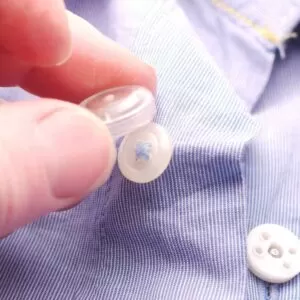
“Buttons are doable but exhausting, especially getting them properly aligned, and clasps with hook closures are a pain to manage.”
One-handed helper for putting on a bra
There are two main products available for this both designed by the same occupational therapist: the Buckingham Bra Angel Dressing Aid is designed to help put on and take off a bra, while the BraBuddy Bra Fastening Aid is a larger device designed specifically for one handed use. The Buckingham Bra Angel Dressing Aid uses a plastic hook and loop, which can be difficult for some users to use, while the BraBuddy Bra Fastening Aid uses plastic hooks and eyes, which are easier to use for most but it is more expensive.
Plastic button hook and zipper pull
The plastic button hook and zipper pull helps people with limited hand function or dexterity in fastening their clothes with ease, or even one-handed. The plastic button hook is a small, lightweight tool that has a loop at one end and a comfortable handle at the other. The hook is used to slip through the buttonhole, and the button is then pulled through the hole. This tool is particularly helpful for individuals if their “good” hand also has arthritis or other conditions that affect their grip strength.
On the other end, the zipper pull has a small hook that attaches to the end of a zip. It enables individuals to grip the zip with one hand and pull it up or down with ease. This tool is particularly useful for individuals who have difficulty reaching behind their backs or have limited hand or finger function.
The plastic button hook and zipper pull is a very low-cost item and portable, making it convenient for travel or sports changing rooms. At such a low cost worth trying to see if it makes a big difference.
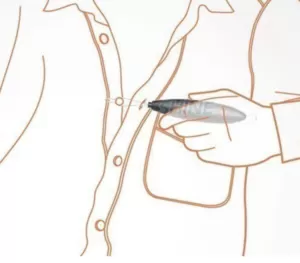
A dressing aid stick
A 27″ sturdy dressing stick can be extremely helpful for someone with only one hand. This lightweight tool allows for easy positioning and retrieving of clothing, which can be difficult for those who can only use one hand. The plastic-coated C hook at one end helps to retrieve clothes from hard-to-reach places, while also assisting with button holes and zippers. The stick also features a special push/pull hook at the other end, which is particularly useful for positioning clothing like a jacket without having to stretch. Overall, this dressing stick is a great tool for anyone who needs assistance with dressing. It is another very low-cost product that may help.
One-Handed Dressing Tips for Specific Clothing
Each piece of clothing requires a different approach when dressing with only one hand.
There are some great tips in the video below by Megan Absten. Megan lost her arm at the age of 14 and had to rely on others to help her get dressed. However, over the past several years, she has learned some incredibly helpful methods for one-handed dressing. In this video, Megan will demonstrate how to button your jeans, put on a bra, and zip up your jacket.
Here are some more helpful tips for putting on specific garments:
Shirts/Blouses/Cardigans
-
- Draw the sleeve onto your affected arm first, then pull the garment up onto your shoulder, having the bulk of the sleeve pulled up past your elbow.
- Insert your other arm into its sleeve.
- To remove the garment, slip it off your affected shoulder first, then off your other shoulder, and work the sleeve off your other arm. Then slide the garment off your affected arm.
Bradley: “Getting dressed as stroke survivior, going from two limbs to one is a massive change, requiring significant adjustments. Buttons and zips are particularly difficult for me as they often require additional support to fasten or lift. This is why I tend to wear more T-shirts than shirts.”
Heavy Coats
- Drape the coat over the back of an upright chair so that the armholes face forward.
- Lower your affected arm into the armhole and pull the coat well up over that shoulder.
- Sit down on the chair and ease your other arm in at the same time.
Jumpers
- Place the garment front down with the neck opening facing away from your body.
- Pick up the garment at the hem using your unaffected hand while supporting your affected arm on a table or chair arm.
- Place your affected arm in the sleeve, pull it on and adjust it.
- Gather the body of the garment up to the neck and pull it over your head.
- Place your unaffected arm in the sleeve.
Trousers
- Sit on the edge of the bed and cross your affected leg over your unaffected one.
- Pull the trouser leg onto your affected leg and proceed in the same manner for the other leg.
- Lie down and pull up the trousers over your hips while rolling from side to side or arching your back and lifting your bottom off the bed.
- Alternatively, stand up and lean with your affected side against a supportive object, then pull up the trousers over your hips and fasten the waistband.
Socks and Knee-High Stockings
- Support your affected leg on your opposite knee and place the sock onto your lap.
- Gather it up as far as possible with your thumb inside it, then place it on your foot and bring it up your leg.
Sock Aids for one-handed use
Sock aids are devices designed to help you put on socks with minimal bending and stretching. They consist of a flexible plastic or fabric sleeve that fits over the foot, with two long handles attached to each side. There are basic sock aids and even giftable premium models! Here’s how they work:
1. The sock aid is placed on a flat surface with the handles facing up.
2. The user sits down and slides their foot into the sock aid’s sleeve.
3. The handles are then pulled up, bringing the sock around the foot.
4. The user can then use the handles to adjust the sock and pull it up to the desired height.
5. Once the sock is in place, the user can simply slide their foot out of the sock aid.
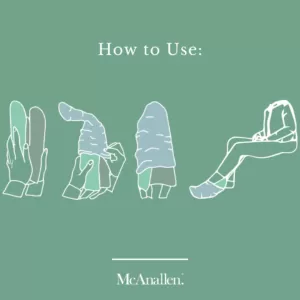
Shoe-Helper reacher grabber shoe aid
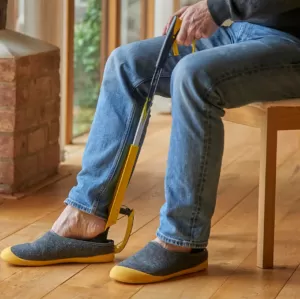
This is a shoe helper that has a built-in shoehorn and gripping aid, designed for people with limited movement or impairments. The plastic shoehorn is gentle on the skin and won’t damage shoes. It can be used with all types of footwear and can also be used to pick up shoes and other everyday items.
Bradley: “Limited clothing options and the need for comfort and accessibility often lead me to choose T-shirts that can easily slip over my head. But even then putting on a T-shirt incorrectly can be frustrating, requiring extra effort to adjust it. They just slip on over the head. The affected arm first left arm first through any hole, then head, then other arm. It’s a bit more flexible, but if a T shirt goes on wrong, it’s a pain to sort of flip it like anyone else normally would again.”
General Tips for One-Handed Dressing
Here are some general tips that can help you dress with one hand:
- Dress while sitting because it’s safer and easier than dressing while standing.
- Dress your affected arm first, and undress it last.
- Use braces or belts to help stabilise trousers and hold them steady.
- Use clothing with elastic waistbands or adjustable closures for ease of use.
- Use dressing aids such as button hooks, zipper pulls, and reachers to make the process easier.
- If you have difficulty reaching behind your down to your feet, try using a long-handled shoehorn to put on shoes or a dressing stick to pull up clothing.
- Consider using slip-on shoes or shoes with Velcro closures for ease of use.
- For women who wear dresses, consider using a slip or undergarment with built-in support to eliminate the need for a bra.
- If you have difficulty with buttons, try using clothing with snaps or hook-and-eye closures instead.
- Fasten clothing while sitting or standing, using your affected arm as an anchor to hold the garment against your body while you join the two sides of the fastening.
Bradley:”Overall, dressing takes much longer, requires more effort, and is tiring compared to able-bodied individuals. With practice and some expert help, you’ll get there!
What are some common challenges that people with one hand face when getting dressed?
What are some common tools and aids that can assist with one-handed dressing?
Are there any specific techniques for putting on certain types of clothing with one hand?
Can one-handed dressing techniques be helpful for people who have mobility or flexibility issues?
Where can I find one-handed dressing aids and tools?
Are there any resources or organizations that can provide support for people with one hand who are struggling with dressing?
Can one-handed dressing techniques be used for children or older adults?
What are some tips for increasing independence and confidence when dressing with one hand?
How can occupational therapy help learn one-handed dressing techniques?
Can one-handed dressing techniques be used for formal wear or special occasions?
Bradley’s designs can be found on his etsy shop at BarrierFreeWorld

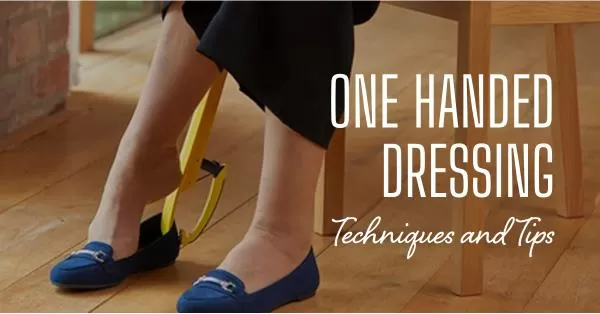
 Dressing with one hand can be a significant challenge, but with the right strategies and tools, it can become manageable. Bradley Cory, a stroke survivor, shares his personal experiences and insights on the topic. “As a stroke survivor for almost 12 years, I have developed strategies to cope with dressing difficulties, but it remains tiring and slow.”
Dressing with one hand can be a significant challenge, but with the right strategies and tools, it can become manageable. Bradley Cory, a stroke survivor, shares his personal experiences and insights on the topic. “As a stroke survivor for almost 12 years, I have developed strategies to cope with dressing difficulties, but it remains tiring and slow.”